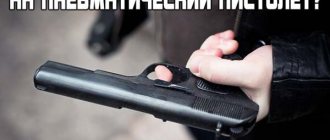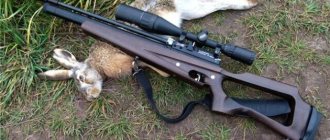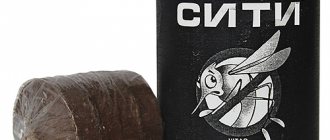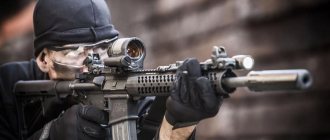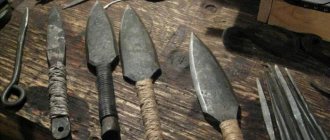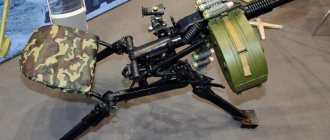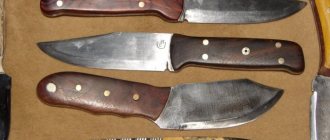How to make an air gun?
To make an air gun you will need the following tools and materials:
- Fitting, car or bicycle;
- 3 wooden blocks:
- The first is 30 cm;
Second - 12 cm;
- Third - 11 cm;
- Dishwashing detergent lid;
- Plastic tube;
- Epoxy adhesive;
- Half liter bottle;
- packaging of metal balls.
In the smallest block, on one side we drill a hole through with a smaller diameter, then with a large drill we drill it halfway.
Cut a hole on the side of the bottle to fit the diameter of the fitting. We glue it with epoxy glue to seal the bottle. Tighten the fitting with a nut.
We cut off the bottle cap a little and insert a plastic tube and also fill it with glue. We also fill the threaded neck of the bottle and tighten the second part of the cap.
We insert the plug with the tube into the hole in the bar. Fill the remaining space with epoxy.
We connect a long block with a short one. On the middle block, cut the edge at a slight angle. We glue a long block to it with its back. Then we glue the ring cut from the cap and glue it to the bottom of the bottle.
Final stage
The last step is to connect the bottle to the air gun.
Hi all. Probably every child, teenager or adult dreamed of acquiring firearms, pneumatic weapons, traumatic weapons, etc. Unfortunately, firearms are prohibited; traumatic weapons require permission. The only option is pneumatics, but the prices for pneumatics are high. Although the principle of its operation is very simple. Today I will show you how to make a simple air rifle. Well, it cannot be called a full-fledged pneumatic weapon, it is an experimental model to show how a pneumatic weapon works. I made this homemade product from unnecessary trash that I found in the barn. I do not bear any responsibility, only you are responsible for all your actions. Even though it’s a fart (let’s call it that), you still need to be careful. Well, let's get started.
To make this homemade product we will need
1. Stainless steel pipe (I decided to make the rifle heavier, but you can choose a PVC pipe or something else) 2. Faucet (you can also use a PVC faucet) 3. Adapter and found a device in the barn I don’t know what it’s for. This device is made from two couplings and two adapters from the hose to the faucet. You can use something else. 4. Nut 5. Sealant
Step 1. Attach the bottle to the adapter
At this stage you need to fix the bottle cap on the adapter. It must be fastened so that no air is allowed to pass through anywhere. First, I made a gasket from the camera, put it on the adapter, and placed another factory gasket on top of it (I found only one factory gasket, so I had to make another one from the camera). We make a hole in the lid and put it on the adapter. We tighten the gasket and tighten the cover with a bolt. We make a hole in the bottle and glue nickel on the inside, and a gasket to the top. The gasket should be pressed tightly against the nipple. Then we hammer the adapter into the coupling.
Step 2.Barrel
Now all that remains is to make the barrel. A stainless steel pipe was used for the barrel. I used another faucet with a welded tube on the end. This tube fit almost perfectly into the stainless steel pipe. I applied sealant to the faucet tube and drove the tube into the pipe. The barrel is ready, now all that remains is to connect both parts (barrel and bottle) and screw on the faucet, as seen in the photo.
Step 3. Test
Pneumatics are a very convenient thing for shooting while fishing or hunting. The power of pressurized air should not be underestimated; with this energy in mind, weapons can be made for specific needs. The most realistic homemade weapon is a pump-action weapon. A separate chamber and a pump are installed here, pumping the required pressure into it. The power will depend on the volume of the tank and the volume of pumped air, and accordingly, you can make an air pump from a bicycle pump with your own hands of the power that is required.
Pneumatic weapons are similar in shape and operating characteristics to combat weapons, but here it is not gunpowder that is used as the energy of the shot, but moving air. The sound of a shot from a pneumatic gun is almost inaudible, that is, the most suitable option for using an air gun is hunting birds and small animals, when the shot of a simple gun scares them.
Pneumatics differ in various characteristics. Different types of weapons include the following indicators: the method of ejection of the cartridge, the dimensions and weight of the gun, its shot force, the scope of use.
According to the method of ammunition release mechanism, an air gun can be:
- Gas spring system. The operating principle is based on the use of a gas spring.
- Spring-piston design. In pneumatics with this method of operation, the bullet receives its initial flight speed under the influence of air squeezed out of the cylinder by the movement of the piston. There is a spring in the storage tank, which pushes the piston out when the hammer is cocked.
- Gas cylinder system. The role of the source of the force of the shot is played by gas cylinders with carbon dioxide. This principle of operation of the mechanism, as a rule, is used not in rifles, but in pistols.
- Electropneumatics. In these guns, air is pumped by an electric motor that is powered by a battery.
There is another classification of pneumatic guns - an indicator of the energy of the bullet's flight.
Taking this criterion into account, guns are divided into:
- The minimum power is no more than 3 J. This pneumatic is lightweight and has a simple design. Used for short-range shooting. For example, in a shooting gallery.
- Soft air guns with a power of approximately 3-3.5 J. Mainly used for teaching shooting skills.
- Paintball gun. Pneumatics with a power of 3.5-7 J. Paint balls are used as ammunition. In appearance they resemble military weapons.
- Magnum class air rifles. The power is about 7.5-25 J. It is used for sports and training purposes and for hunting small animals.
- Powerful pneumatics with power ratings of over 25 J are used for hunting and military operations. In terms of muzzle energy, it can be compared to combat rifles.
Many of the guns have a power that is no more than 7 J, since purchasing this rifle does not require a license or special storage conditions. Powerful pneumatics can be purchased to order and only after obtaining the appropriate permission.
When choosing a pneumatic gun, you must first determine what the gun will be used for. If you need a rifle for recreational shooting, then you can choose an inexpensive, simple model that has a minimum of power. If you are purchasing pneumatics for hunting purposes, you need to choose a Magnum class shotgun.
When purchasing, you need to pay attention to the following characteristics of the gun, such as:
- Accuracy, which will depend not only on how well the polishing was done inside the barrel, but also on the installation of the sighting device. Budget products have a conventional sight in the form of a comb at the end of the barrel. Optics for pneumatics can be purchased additionally. Modern expensive guns come with an optical sight included.
- Power is one of the main indicators. The more powerful the gun, the better the lethal energy of the ejected cartridge and the more accurate the shot. For hunting purposes and sports training shooting, only very powerful guns can be used.
- Price. If you want to buy something of high quality that is used for various purposes, in particular for hunting, you need to count on a decent price for the weapon.
- Pneumatic material. The reliability and duration of operation of the weapon will depend on this characteristic. Most air weapons are made from wood and weapon steel, but today you can see models made from plastic composite and its types. They cost a little, but are not that reliable and are relatively risky to use.
- Manufacturing mechanism. Both the weight of the gun and the initial speed, as well as the trajectory of the cartridge when fired, and the accuracy of fire will depend on this characteristic. The cost of the shot depends on the option for obtaining power. For example, for gas-cylinder pneumatics you need to purchase CO2 cylinders. Which, considering the price of one can, is quite significant.
When purchasing a pneumatic gun for small game hunting purposes, only a powerful gun is suitable. For the hunt to be successful, the air bag must be made with high quality. How to choose an air gun for hunting is a separate question.
Shotguns became the most popular. Due to the huge selection, this manufacturer is a leader in the weapons market. Expensive models have installed optics.
How much pneumatics will cost depends on the technical indicators and the manufacturer. The most expensive are European brands. The cheapest MP512M shotgun is a Russian-made weapon.
The assembly technology is not complicated, which made the whole process simple and inexpensive. As a rule, the valve is considered the most complex mechanism during the assembly of this type of gun; it must open instantly when the trigger is pressed. However, there are no problems with this; the trigger mechanism is not complicated and works great.
Materials and tools
List of required tools:
- screwdriver;
- epoxy;
- small hammer;
- welding;
- pliers.
List of required materials:
- a piece of rubber hose;
- a piece of PVC pipe and 2 plugs (required for the cylinder);
- metal wire;
- timber (base of weapon);
- sheet metal (necessary for making brackets);
- self-tapping screws;
- 2 metal clamps;
- metal tube for installing the barrel;
- 2 copper pipes (for connecting hoses to the cylinder);
- bicycle pump directly;
- a piece of elastic from the camera.
Instructions
Stage one - the theory of the compression chamber.
All elements of this homemade weapon were made in advance; here we only show how the pneumatics are assembled. The cylinder is presented in the form of a piece of PVC tube where the plugs are located. The latter must be secured firmly and sometimes there is not enough glue; it is best to fasten them with self-tapping screws. In this case, the most important thing is that the cylinder is sealed and can withstand high pressure.
There is one fitting at both ends of the tank. As the latter, you can use pieces of tubes; remember that they must have a fairly large cross-section in order to quickly release the compressed air. We drill holes for the pipes and install them with epoxy.
Then a piece of soft tube is placed on one of the fittings; it looks black in the photo. You need to wrap insulation around the second fitting, and the pump is connected to it. If it does not have a check valve, then it must be included in the structure. Fum tape can be used as insulation.
As for the volume of the cylinder, in this case an individual approach is required. By and large, one shot is fired, so it is useless to make it very large. In pneumatics, the cylinder is small, but it is already powerful. It is not the volume, but the pressure of compressed air that is required.
Stage two – attaching the cylinder to the base
.
A timber was used as a base for the pneumatics, which was given the required profile. In this case, you need to work with a knife, make a series of holes and the like, in general, there is nothing complicated.
We supply a black hose and attach soft sheet metal to the cylinder. Next, you need to make brackets from it for fastening, taking into account the shape of the camera, and then secure it to the base using self-tapping screws. It is best to place an elastic band under the clamps; a bicycle inner tube is suitable for this role.
Stage three - installation of a bicycle pump
.
The entire structure is powered by a pump. First, it connects to the camera. What is used for is a small piece of rubber hose and several metal clamps. You need to carefully tighten the latter so as not to bleed air.
Next, attach the pump to the pneumatics. It must be secured firmly, since it may come off during air pumping. In this case, everything is secured with one clamp, but this is not very reliable. You need to put a rubber band between the clamp and the pump, otherwise it will slide.
Stage four - securing the trigger
mechanism.
In this case, you will need a soft black hose running to the barrel from the cylinder. To prevent air supply, you just need to block access to it in the hose.
To clamp the hose, a special design is used, made of metal wire, which is welded or soldered. It is attached to the trigger. When pressed, the hose opens and air from the cylinder enters the barrel. Everything is fixed with 2 self-tapping screws and 1 steel pin, driven into the beam and holding the hook.
Stage five -
attaching the barrel.
A metal pipe was chosen as the trunk. A black hose coming from the cylinder is connected to it. Everything is secured with a steel clamp, otherwise the hose will be torn off by the pressure. The barrel itself also needs to be firmly secured with homemade metal clamps and rubber bands from a bicycle inner tube.
The gun is assembled. Finally, you need to take care that the wooden beam does not absorb moisture. It is best to treat with linseed oil.
Stage six – testing
.
First you need to shut off the black hose with the trigger. Then air is pumped into the cylinder. What volume to pump is determined experimentally. It is important not to over-pump, as very high pressure will rupture the cylinder. The pressure must be created so that the cartridge has time to develop maximum speed.
Shoot the rifle and write down how many times you need to pump air.
Air sniper rifles
Nowadays this type of weapon is most often used for playing airsoft and hunting with air guns for birds. Read about airsoft snipers here. Let's look at rifles created on the basis of the SVD.
CYMA CM057 LED 3K
CYMA CM057 LED 3K
Fully corresponds to the original in dimensions. There is a cheek pad for ease of shooting and a fire switch (safety and semi-automatic). Unlike other models, the battery is located in the forend.
Pros:
- Small size.
- Equipped with SVD RS.
- High maneuverability.
- Well located center of gravity.
Main characteristics:
| Weight | 3100 gr |
| Initial bullet speed | 130-140 m/s |
| Magazine capacity | 120 |
| Caliber | 7.62 mm |
| Length | 1090 mm |
| Aim | hop-up with adjustment. |
| Price | from 13,000 rubles |
SVD Rifle AEG (120936) King Arms Dragunov
SVD Rifle AEG (120936) King Arms Dragunov
Pneumatic double SVD, made of high-strength plastic and metal. There is an AEG system that allows you to pump air to create the required pressure.
The rifle is equipped with a special device consisting of a pump feed device and a battery. When fired, it raises the pressure to the desired level and delivers the ball into the barrel. It is distinguished by high shooting accuracy at a decent distance (up to 50 m).
A very popular SVD model, it is eagerly used by amateur athletes, participants in historical reenactments, and bird hunters. Additional equipment with optics is possible.
Main characteristics:
| Weight | 3175 gr |
| Initial bullet speed | 131 m/s |
| Magazine capacity | 200 |
| Caliber | 6 mm |
| Length | 1210 mm |
| Aim | adjustable rear sight |
| The price is | about 10,500 rubles. |
Read more about Russian 12.7 caliber sniper rifles.
ASG SVD-S
ASG SVD-S
A copy of the folding model of this weapon (SVDS, 1990). The elongated shape of the butt and a comfortable handle (made like a pistol grip) make it possible to easily move while holding this rifle in your hands.
Pros:
- Spacious store.
- Adjustable optics.
- It is possible to install a sight.
Main characteristics:
| Weight | 3500 gr |
| Initial bullet speed | 95 m/s |
| Magazine capacity | 200 |
| Caliber | 8 mm |
| Length | 1100 mm |
| Aim | hop-up with adjustment |
| Price | from 8400 rubles |
It is worth reading the material about the best sniper rifle.
SVD Spring Rifle
SVD Spring Rifle
Excellent assembly and complete absence of play creates the feeling that you are dealing with a real military weapon. The sight is the same as the AK 47.
The butt and fore-end are made of polymer materials of special strength; the barrel, body, bolt cover and sight are made of metal.
Main characteristics:
| Weight | 2690 gr. |
| Initial bullet speed | 130 m/s |
| Magazine capacity | 60 |
| Caliber | 7.62 mm |
| Length | 1200 mm |
| Aim | hop-up with adjustment. |
| Is this model worth it? | about 5,000 rubles |
For an overview of the sniper rifle, watch the following video:
We comply with safety measures
There are several rules for the safe operation of pneumatics:
- If the weapon is not in use, it must be unloaded and decocked. It is necessary to load the rifle only at the shooting range, and after you are ready to shoot. It should be discharged only after finishing - before it is packed in a case.
- Treat every rifle as if it were loaded. Hold the barrel so that it is pointed in a safe position.
- Safe storage of pneumatics is also important, as is its operation. The rifle should be stored in a gun safe, unloaded, and locked. It is necessary to limit the access of small children. Do not forget that in childhood any gun is of great interest. The owner of the weapon will have to answer for the consequences.
- Certain models of pneumatics, after charging the spring, can only be discharged with a shot. Moreover, it must be remembered that you cannot fire a blank shot from a spring-piston gun - this will lead to rapid failure of the weapon. And accordingly, in order to discharge it, you need to shoot the bullet in a safe direction. But empty shots do not harm PSP and CO2 weapons. Read the operating instructions.
- There is no need to touch the trigger if you are not confident in the shot. You need to train yourself to keep your finger further from the hook (on the bow or behind it). There is no need to attempt to pull the trigger if the rifle is locked with the safety catch.
- Do not rely on the fuse or other safety measures. You need to approach every rifle with the feeling that it will fire at any time, even without pulling the trigger. Both the fuse and the trigger are only mechanical devices. Like everything, they can break. At the same time, the human factor (disassembly was performed incorrectly, incorrect adjustment) is much more likely to cause involuntary shots.
- Choose only suitable cartridges. Any gun needs to use bullets of the exact specified type and caliber. The use of others will result in damage to the gun or accidents resulting from uncontrolled shooting.
- You need to be clearly sure of the target and what is behind you. The cartridge does not stop in the air. There is no need to shoot until you are sure where the cartridge will end its flight and what obstacles it may encounter along the way.
- Use personal protective equipment for your eyes and ears. While this generally applies to military weapons, certain models of air rifles can be quite loud in indoor shooting ranges.
- If the air gun does not fire when you press the trigger, you must be extremely careful. The risk of an unexpected discharge with a broken gun is much greater than usual. You need to point the barrel in a safe area and handle the pneumatic with the utmost care. If a gun fails once, there is a good chance it will happen again.
- You should not modify your gun without the necessary training, but you should maintain it regularly. Modifications will require training and skill. This also applies to pneumatics. Serious improvements should be left to professionals.
- Before shooting, you must make sure that the barrel channel is clean. The presence of third party items will cause the weapon to malfunction.
- You must shoot only when sober! Just like driving a car, pneumatics are a highly dangerous subject.
- Each weapon is subject to wear and tear, requiring periodic cleaning and care, and timely replacement of broken elements. The main part of the care tips that are suitable for a specific weapon model is found in the instruction manual.
It is necessary to explain the above rules to all people who may have access to pneumatics, including relatives and small children. Do not store filled pressurized cans for PSP rifles at home or in the car. Regularly repressurize containers with increased pressure. Use common sense and always imagine the consequences of further actions.
Can air produce a significant effect?
For example, we need to blow away a stack of books with air from our lungs ( by the way, a great item for betting with friends
).
No matter how hard you try, this task is impossible for humans (supermen and other superheroes do not count). No matter how much we blow, the books will remain in place. But what if we cheat a little and put a regular inflatable ball under a stack of books and blow air into it. You will notice that without the slightest effort our books will rise above the table. And we used the same air from our lungs ( you can proudly emerge victorious from the dispute
).
The difference is that in the second case we locked our air in a limited space and did not allow it to spread in all directions. And when the air has nowhere to go, it begins to work like a spring.
This compressed state of air and gas is studied by pneumatics. Pneumatics
(from Greek breathing, blowing) - a branch of physics devoted to mechanisms and devices that use gas pressure differences for their work.
In other words, any pneumatic device uses compressed gas in its operation.
Pneumatic mechanisms are found all around us. These are the brakes in buses, trolleybuses and trucks, these are the doors in the same buses (have you heard how the compressed air hisses when opening?!), these are the jackhammers that are used to make holes in the asphalt...
...and of course air guns.
Popular fun Paintball
(Paintball), where people run around with guns and shoot paint balls at each other, I’m sure everyone knows. I recommend it to anyone who hasn't played it!
So in this article we will tell and show you how to make a real pneumatic gun with your own hands - a compressed air gun.
What is such a gun capable of?! Let's look:
Materials:
plastic bottle 1.5 l.;
bicycle nipple;
plumbing adapter with faucet (from ¾ inch to ½ inch), coupling (¾ inch), piece of metal-plastic pipe 70 cm (diameter ½ inch), sealing tape.
The last picture shows alternative parts (we didn't have them at first) that also work great for our application (½ to ¾ tap adapter and ¾ female coupling).
Equipment:
superglue, nail or wide-headed screw, scissors, torch, knife, pliers, gas wrench, file.
Step 1.
Cut the thread from the bottle using a knife. We file off the remains with a file or sandpaper.
Step 2.
Using a wide-headed screw heated over the fire of an alcohol lamp (or gas stove), we melt a hole in the bottom of the bottle.
Step 3.
We cut off the nipple from the old bicycle inner tube and insert it into the hole in the bottom of the bottle from the inside. For this:
- We pass the thread through the holes of the bottle.
- At the end of the thread we tie our nipple, and pull the other end.
- In this way you can easily thread the nipple from inside the bottle.
Step 4.
Glue the nipple to the bottle with superglue. The main thing is to ensure 100% tightness of the gluing, otherwise we will not be able to inflate the bottle to sufficient pressure.
To improve gluing, you can first clean the hole in the bottom with a file from the outside and inside, get rid of burrs, glue a rubber washer cut from the same old bicycle inner tube (both inside and outside); you can use sealant or hot melt adhesive; But you can combine it all.
Remember about the tightness and rigidity of the structure so that when connecting the pump our nipple does not come off.
Step 5.
Screw a ¾-inch coupling onto the neck of the bottle. Because The neck of the bottle is plastic, it can be screwed on quite well without preliminary threading. Screw the coupling all the way into the outer rim of the neck. If necessary, use a gas wrench.
Step 6.
We screw our tap into the second end of the coupling. We first seal the tap threads using plumbing sealing tape. (You can compact it in any other way convenient for you).
Let me remind you once again that the tightness of the structure is very important to us.
Step 7
We screw a piece of metal-plastic pipe with a diameter of ½ inch onto the tap thread. The thread may not need to be pre-cut, because... The plastic inside the pipe can easily be screwed tightly onto the tap thread itself.
We took a piece of pipe 70 cm in length.
Step 8
Our air gun is ready! We enjoy the fruits of our labor and prepare for the challenges.
See detailed video assembly instructions below:
To test an air gun we will need:
1) pump (preferably with a pressure gauge to control the pressure in the bottle),
2) projectiles (paintballs, fruits, vegetables, water, paper balls... whatever).
Instructions for use:
- Close the tap.
- Pump air into the bottle to 3-4 atmospheres. Be careful not to over pump the bottle. (At a pressure of 6 atmospheres, my bottle exploded.)
- We load the gun with our projectile through the barrel.
- We aim and shoot by sharply opening the tap.
Attention! All operations with compressed air should be performed under adult supervision!
Do not point at people or animals!
Pneumatics can become a dangerous weapon in the hands of people without a sense of proportion and responsibility for their actions.
Good luck!
Dear readers! The article was published a long time ago and was written for specific videos in the “humor” category. Over time, many creators have chosen to remove their videos from YouTube. Nothing can be done about this, and there is no point in rewriting the article from scratch. So I leave the corresponding inserts in place of the removed rollers. For history, many of the carved examples of manufacturing were quite interesting.
All owners of pneumatics sooner or later have a desire to tune their favorite - increase power, accuracy, make a beautiful body kit. The extreme form of such an activity turns into a desire to create something of one’s own. We will talk further about how they make pneumatic weapons with their own hands in Rus'.
The original idea of the article was far removed from the current content; drawings, diagrams, manuals, the best original works, etc. were planned.
Expected
But after viewing the available information on YouTube, the worldview on this problem has changed; what happens next can contribute to causing nervous paralysis and the wildest criticism. So it’s better for the faint of heart to look for something else. And yes... there will be a lot of videos so that you can experience the same thing that I did. But first, a little educational program on this Wednesday, so that the hearts of seasoned pneumatic pipes certainly don’t skip a beat.
Design Features
PCP air rifles use compressed air or other gases when firing, just like any other pneumatic gun. But the peculiarity of these rifles is that air is pumped into a special reservoir, which is located under the barrel. Air is pumped using special cylinders that are not included in the weapon system. However, this rule is not strict and many PCP rifles can accommodate this cylinder in their design. But for some options, refueling always occurs using devices such as a pump for a PCP rifle, a compressor, or a pumping station. This is due to the fact that high-quality filling of the cylinder requires high pressure (200-300 atm), and this indicator cannot be achieved with manual filling. In this case, carbon dioxide, nitrogen or air is used to fill the cylinder.
The design of such a rifle uses a special gearbox, which is designed to reduce air pressure as it exits the barrel. This solution is used because different gases behave differently. While carbon dioxide is affected by temperature, air and nitrogen are less sensitive. Therefore, it is important to know what kind of gas is used in the rifle you purchase. Depending on this, the gearbox is also selected.
It is equally important to strictly follow safety rules when working with tanks that contain liquefied air. Any careless handling of them may result in an accident that could cause harm to the owner of the rifle. A rupture of the cylinder or hose to which the PCP rifle refill station is connected is a rather unpleasant occurrence, so you should try to avoid it.
Operating principle
A slight evolution of weapons from our childhood. Surely everyone reading this has thrown a stone at someone at least once in their life? Surely almost everyone had a couple of dozen slingshots? And who made a crossbow with elastic bands and a clothespin? Has anyone used inflated bottles among throwing weapons? Now, if the memory begins to recover, then we continue.
Since homemade pneumatic weapons in our country today are not shown by high masters of this business, the main principles of creating them are simpler and cheaper. Therefore, the basic principles of operation of such weapons:
- rubber(!!!)-piston pneumatics - based on “syringes” and rubber bands
- PCP – no matter how cool it sounds, based on a plastic bottle and a bicycle pump
It is these two classes that describe the entire model range of inexpensive homemade pneumatics on the Internet. There are also options with flammable liquids... but this is another level.
Manufacturers of PCP rifles
Nowadays the commercial market is quite developed, so you can find many manufacturers of PCP rifles. Each of them has its own approach to the production of weapons and their improvement. However, among those who produce the best PCP rifles are the following:
— Crosman is a fairly well-known American company that approaches the production of its weapons with the utmost seriousness. It is known for the quality of production, as well as the original design of weapons. Its latest line, the Benjamin Sheridan, features a design that minimizes recoil and vibration when fired.
— BSA Guns is a British company that produces firearms and air guns. Its products are widely known throughout the world. The company produces weapons for both right-handed and left-handed shooters. Its rifles are versatile and suitable for both sport shooting and hunting or entertainment.
— Diana is a German company specializing in the production of various air guns. They are known for producing quality rifles through tight controls at every stage of production. This weapon is often chosen by professionals in sports disciplines. An example is the Diana-52 PCP rifle.
— Hatsan is a Turkish company. She is new to the airgun market. PCP Hatsan air rifles are known for their design as well as the use of advanced technology.
— Walther — this company needs no introduction. In the early and mid-twentieth century, it produced weapons exclusively for the needs of the German army. Subsequently, subsidiaries were opened that produce air guns, known for their reliability and quality.
Masters
It remains to be seen who the very magicians of modern cheap pneumatics are. No, gentlemen, these are not plumbers or even Mario. In the video, it is mostly children who are making samples of light hardball weapons... Apparently, children of hardball players (since a bottle of “Vstrel” was spotted, I really love it). Or airsoft plumbers (judging by plastic trends). Or partially conjugated... Let’s not get carried away with such a terrible “Santo Barbara”, but something here is clearly not clean. I suggest you start getting acquainted with exemplary videos from around the world.
What is a PCP rifle?
The abbreviation PCP stands for pre charged pneumatic, which means “pre-charged pneumatics”. This means that the rifle is loaded with a special device automatically or manually before each shot. This design of pneumatic small arms is the most popular on the market, as it has some advantages over other layouts:
— when firing from a PCP rifle there is practically no recoil, and this can significantly increase the accuracy of the shot;
— the design of the rifle is made using innovative technologies and was developed relatively recently;
— the design features of the rifle (pumping system), as well as increased shot accuracy, allow it to come closer to a full-fledged firearm.
These indicators have made PCP rifles the most popular on the modern market of hunting and sporting weapons. Moreover, in countries such as Ukraine or Russia, PCP rifles can be purchased freely without a license.
Bonus!!!
And finally, just a cool video about a homemade pneumatic pistol with a high changeable caliber - potatoes. For those who have something like this lying around in their cellars since winter, I suggest switching to such a projectile. Moreover, production is as simple as shelling pears.
That's all. So we learned how to make air guns in the most difficult and limited conditions. Danila Bagrov with his plumbing sawn-off shotgun simply does not live up to the level. And due to the young age of the main participants, it’s even scary to imagine what will happen to hardball in 10 years. Stay with us, play, shoot, and most importantly, don’t keep all this higher-level nonsense in your head. Have a great weekend everyone!!!
